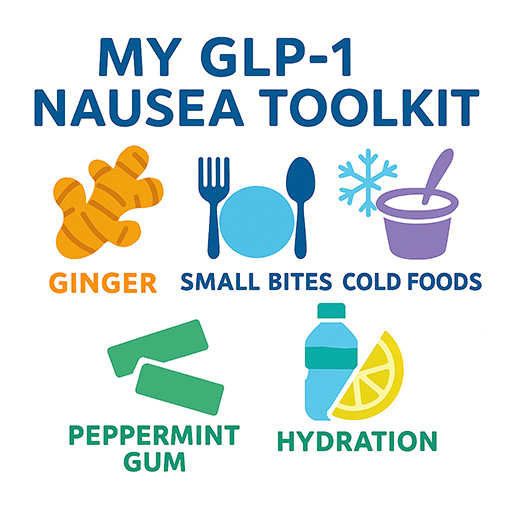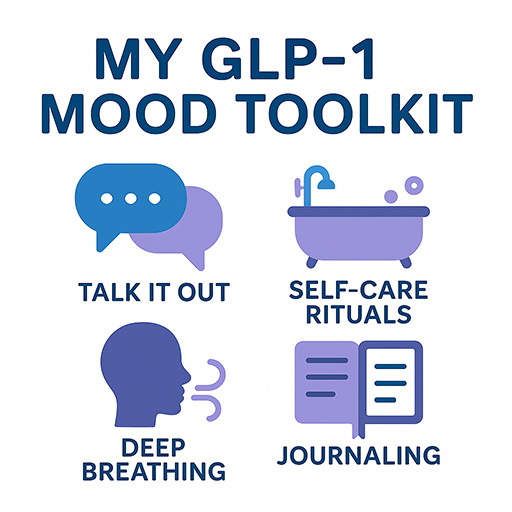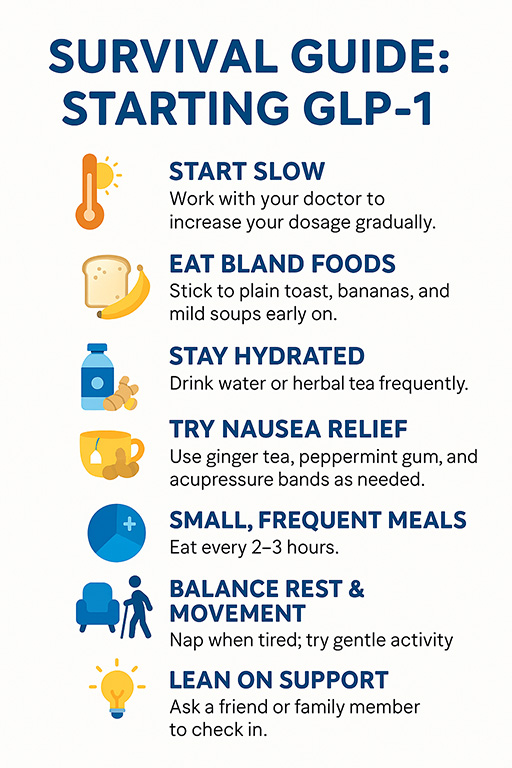Author’s Note: Claire Aldington is a fictional character used to share patient insights. This article for the question “The Side Effects No One Talks About: My Honest GLP-1 Experience”, is based on personal perspective and research and should not be taken as medical instruction. Always consult a professional for personal health decisions.
A Rough Start:
Early GLP-1 Side Effects
When I decided to begin GLP-1 therapy, I expected change. I knew it could help with appetite, weight, and some health markers. However, I wasn’t prepared for how intense the early side effects would be.
People told me I might feel “a little nauseous” or “a bit tired,” but the reality was far rougher. In fact, Mayo Clinic notes that common GLP-1 side effects include nausea, vomiting, diarrhea, and headache.Mayo Clinic
Even though doctors often reassure me that these effects can improve with time, I felt them all at once. By week six, things had improved dramatically. I began to accept that sticking with treatment was worth it.
(Wondering how long you might stay on GLP-1? I’ve explored that answer, too.)

Nausea, fatigue, headache — the first weeks hit harder than she expected. An AI-generated image of Claire.
Starting GLP-1 Treatment
🔥Hot Tip🔥
The first two days went surprisingly smoothly. I even questioned whether I had received a placebo. Then everything changed on day three. A wave of nausea hit me like mild motion sickness. Suddenly food lost its appeal, and I survived on crackers and protein shakes.
A few days later, fatigue settled in. By the end of the first week, I felt wiped out by mid-afternoon. My brain felt foggy and simple tasks were frustrating. Taking short walks helped clear my mind, but I still mostly wanted to nap.
What Helped My Stomach
Nausea was my constant companion for the first few weeks of treatment. On most days it was mild queasiness. Occasionally I vomited — gently, not violently — usually after eating too fast or too much. Research shows that gastrointestinal symptoms are the most common side effects of GLP-1 medications.
The good news is it typically gets better with time, giving me hope for the future. Here are some things that helped me manage the queasiness:
💡 Fun Fact 💡
Ginger: I kept ginger tea bags, ginger chews, and ginger candies everywhere. A sip of ginger tea or a piece of ginger candy helped calm my stomach.
Small bites: I switched to small, frequent meals. Oatmeal became my go-to breakfast, eaten one spoonful at a time.
Cold foods: Chilled shakes, yogurt, and fruit were much easier to tolerate than hot meals when I felt sick.
Peppermint gum: Chewing peppermint gum surprisingly helped reduce nausea after a meal.
Hydration: I sipped water with lemon or low-sugar electrolyte drinks throughout the day. Staying hydrated really made a difference.

A cheat-sheet of my best tips for calming nausea, a temporary side effect of GLP-1 medication.
Unexpected Fatigue
🔥Hot Tip🔥
I expected nausea, but I didn’t expect to feel like I’d been hit by a wave of exhaustion. The tiredness peaked in the afternoons, and on some days I could barely keep my eyes open.
When I felt drained, I prioritized rest. Going to bed even 30–45 minutes earlier made a big difference. I also found that short walks or gentle movement often gave me more energy than coffee ever could.
The Ups and Downs
This one really blindsided me. I felt fragile, emotional, and sometimes inexplicably anxious. It was like I had no emotional buffer. Some people on GLP-1 medications have reported worsened depression or anxiety.Medical News Today
However, a large analysis of semaglutide trials found no overall increase in depression or suicidal thoughts among users without prior mental illness.Penn Medicine Experts also note that mood changes can be driven by weight loss itself, and that serious psychiatric side effects are very rare.Medical News Today
Talking openly about my feelings helped a lot. I explained what I was going through to my husband, and having his support made me feel less alone. Creating simple self-care routines also helped me reset on tough days. I took lavender baths, listened to soothing audiobooks, and practiced deep breathing.
Finally, I started keeping a simple journal of how I felt each day. Spotting patterns helped me prepare for rough patches and feel more in control.

These tips helped me work through the emotional mood swings, a temporary side effect of GLP-1 medication.
What Got Me Through
GLP-1 Side Effects

Start slow: Work with your doctor to increase your dosage gradually. A slower start can soften the intensity of side effects.
Eat bland foods first: I stuck to plain toast, bananas, and mild soups early on. I avoided spicy or greasy dishes when I felt queasy.
Stay hydrated: Drink water or herbal tea frequently. Dehydration can worsen both nausea and fatigue.
Try nausea relief: I used ginger tea, peppermint gum, and acupressure bands as needed. These helped curb the nausea spells.
Small, frequent meals: Eating a few bites every 2–3 hours helped keep my blood sugar steady and made side effects more tolerable.
Balance rest and movement: When I was tired, I allowed myself to nap. But gentle walks and light activity often boosted my energy and lifted my mood.
Lean on support: I asked a friend or family member to check in on me regularly. Having someone care about my journey made a big difference.
Focus on your ‘why’: Whenever I felt discouraged, I reminded myself of my reasons for starting. Keeping my health goals in mind helped me push through the tough days.
If you’re struggling with GLP-1 side effects right now, don’t lose hope – it gets better, and there are GLP-1 treatment tips to help you start strong.
It Got Better. A Lot Better.
Around week six, everything changed. I could enjoy food again without fear. My energy was back, and my mood had balanced out. Those nausea, fatigue, and emotional dips felt like the price I paid for something worthwhile.
What I got in return was improved health and sustainable weight loss, along with a stronger sense of myself. If you’re struggling with GLP-1 side effects right now, hold on.
Remember that these effects are usually temporary. Over time, many people find relief as their bodies adjust, and eventually the benefits become clear.RMCOEH PMC
You’re not alone, and you will get through this chapter.
You are not alone, and you will get through this chapter.
💡 Fun Fact 💡
Disclaimer: This article is a personal narrative intended for informational purposes. It is not medical advice. Consult a healthcare professional for guidance on weight loss or any medical treatment. Also, note that Claire Aldington is a fictional character created to illustrate real experiences.
Cited Sources
Mayo Clinic. Diabetes drugs and weight loss Mayo Clinic
PMC. Adverse Effects of GLP-1 Receptor Agonists PMC
RMCOEH. Once-Weekly Semaglutide in Adults with Overweight or Obesity RMCOEH
University of Queensland. Considering taking a weight-loss drug like Ozempic? Here are some potential risks and benefits University of Queensland
Medical News Today. GLP-1 drugs tied to lower brain inflammation, higher depression risk Medical News Today
Penn Medicine. Semaglutide and mental health Penn Medicine








